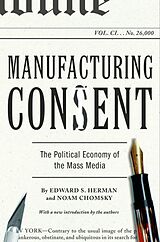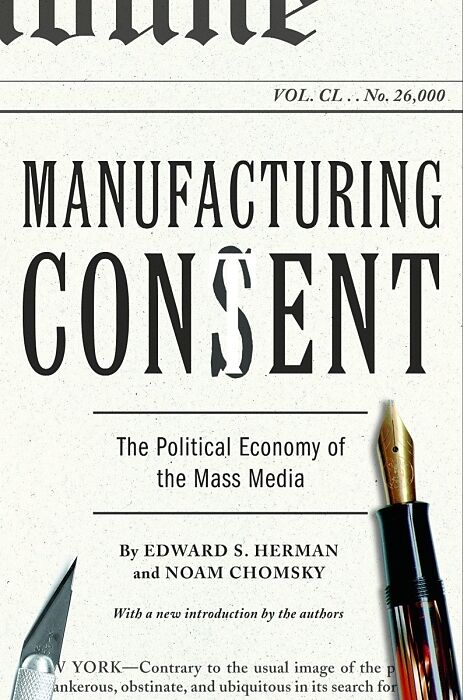Manufacturing Consent
Einband:
Broschiert
EAN:
9780375714498
Untertitel:
The Political Economy of the Mass Media
Genre:
Geschichte
Autor:
E.; Chomsky, N. Herman
Herausgeber:
Vintage Books N.Y.
Anzahl Seiten:
480
Erscheinungsdatum:
15.01.2002
ISBN:
0375714499
Zusatztext "[A] compelling indictment of the news media's role in covering up errors and deceptions in American foreign policy of the past quarter century." Walter LaFeber, The New York Times Book Review Informationen zum Autor EDWARD S. HERMAN is Professor Emeritus of Finance at the Wharton School of the University of Pennsylvania. NOAM CHOMSKY is Professor, Department of Linguistics and Philosophy, at the Massachusetts Institute of Technology. Klappentext In this pathbreaking work, Edward S. Herman and Noam Chomsky show that, contrary to the usual image of the news media as cantankerous, obstinate, and ubiquitous in their search for truth and defense of justice, in their actual practice they defend the economic, social, and political agendas of the privileged groups that dominate domestic society, the state, and the global order. Based on a series of case studies-including the media's dichotomous treatment of "worthy" versus "unworthy" victims, "legitimizing" and "meaningless" Third World elections, and devastating critiques of media coverage of the U.S. wars against Indochina-Herman and Chomsky draw on decades of criticism and research to propose a Propaganda Model to explain the media's behavior and performance. Their new introduction updates the Propaganda Model and the earlier case studies, and it discusses several other applications. These include the manner in which the media covered the passage of the North American Free Trade Agreement and subsequent Mexican financial meltdown of 1994-1995, the media's handling of the protests against the World Trade Organization, World Bank, and International Monetary Fund in 1999 and 2000, and the media's treatment of the chemical industry and its regulation. What emerges from this work is a powerful assessment of how propagandistic the U.S. mass media are, how they systematically fail to live up to their self-image as providers of the kind of information that people need to make sense of the world, and how we can understand their function in a radically new way. Introduction This book centers in what we call a propaganda model, an analytical framework that attempts to explain the performance of the U.S. media in terms of the basic institutional structures and relationships within which they operate. It is our view that, among their other functions, the media serve, and propagandize on behalf of, the powerful societal interests that control and finance them. The representatives of these interests have important agendas and principles on behalf of, the powerful societal interests that control and finance them. The representatives of these interests have important agendas and principles that they want to advance, and they are well positioned to shape and constrain media policy. This is normally not accomplished by crude intervention, but by the selection of right-thinking personnel and by the editors' and working journalists' internalization of priorities and definitions of newsworthiness that conform to the institutions policy. Structural factors are those such as ownership and control, dependence on other major funding sources (notably, advertisers), and mutual interests and relationships between the media and those who make the news and have the power to define it and explain what it means. The propaganda model also incorporates other closely related factors such as the ability to complain about the media's treatment of news (that is, produce flak), to provide experts to confirm the official slant on the news, and to fix the basic principles and ideologies that are taken for granted by media personnel and the elite, but are often resisted by the general population. In our view, the same underlying power sources that own the media and fund them as advertisers, that serves as primary definers of the news, and that produce flak and proper-thinking experts, also play...
Autorentext
EDWARD S. HERMAN is Professor Emeritus of Finance at the Wharton School of the University of Pennsylvania.
NOAM CHOMSKY is Professor, Department of Linguistics and Philosophy, at the Massachusetts Institute of Technology.
Klappentext
In this pathbreaking work, Edward S. Herman and Noam Chomsky show that, contrary to the usual image of the news media as cantankerous, obstinate, and ubiquitous in their search for truth and defense of justice, in their actual practice they defend the economic, social, and political agendas of the privileged groups that dominate domestic society, the state, and the global order.
Based on a series of case studies-including the media's dichotomous treatment of "worthy" versus "unworthy" victims, "legitimizing" and "meaningless" Third World elections, and devastating critiques of media coverage of the U.S. wars against Indochina-Herman and Chomsky draw on decades of criticism and research to propose a Propaganda Model to explain the media's behavior and performance. Their new introduction updates the Propaganda Model and the earlier case studies, and it discusses several other applications. These include the manner in which the media covered the passage of the North American Free Trade Agreement and subsequent Mexican financial meltdown of 1994-1995, the media's handling of the protests against the World Trade Organization, World Bank, and International Monetary Fund in 1999 and 2000, and the media's treatment of the chemical industry and its regulation. What emerges from this work is a powerful assessment of how propagandistic the U.S. mass media are, how they systematically fail to live up to their self-image as providers of the kind of information that people need to make sense of the world, and how we can understand their function in a radically new way.
Leseprobe
Introduction
This book centers in what we call a “propaganda model,” an analytical framework that attempts to explain the performance of the U.S. media in terms of the basic institutional structures and relationships within which they operate. It is our view that, among their other functions, the media serve, and propagandize on behalf of, the powerful societal interests that control and finance them. The representatives of these interests have important agendas and principles on behalf of, the powerful societal interests that control and finance them. The representatives of these interests have important agendas and principles that they want to advance, and they are well positioned to shape and constrain media policy. This is normally not accomplished by crude intervention, but by the selection of right-thinking personnel and by the editors’ and working journalists’ internalization of priorities and definitions of newsworthiness that conform to the institutions policy.
Structural factors are those such as ownership and control, dependence on other major funding sources (notably, advertisers), and mutual interests and relationships between the media and those who make the news and have the power to define it and explain what it means. The propaganda model also incorporates other closely related factors such as the ability to complain about the media’s treatment of news (that is, produce “flak”), to provide “experts” to confirm the official slant on the news, and to fix the basic principles and ideologies that are taken for granted by media personnel and the elite, but are often resisted by the general population. In our view, the same underlying power sources that own the media and fund them as advertisers, that serves as primary definers of the news, and that produce flak and proper-thinking experts, also play a key role in fixing basic principles and the dominant ideologies. We believe that what journalists do, what they see as newsworthy, and what they take for granted as premises of their work are frequently well explained by the incentives,…

Leider konnten wir für diesen Artikel keine Preise ermitteln ...
billigbuch.ch sucht jetzt für Sie die besten Angebote ...
Die aktuellen Verkaufspreise von 6 Onlineshops werden in Realtime abgefragt.
Sie können das gewünschte Produkt anschliessend direkt beim Anbieter Ihrer Wahl bestellen.
Loading...
Die aktuellen Verkaufspreise von 6 Onlineshops werden in Realtime abgefragt.
Sie können das gewünschte Produkt anschliessend direkt beim Anbieter Ihrer Wahl bestellen.
| # | Onlineshop | Preis CHF | Versand CHF | Total CHF | ||
|---|---|---|---|---|---|---|
| 1 | Seller | 0.00 | 0.00 | 0.00 |
